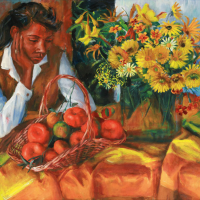20. MARGARET OLLEY

Patricia with Fruit and Flowers belongs to a rare and important group of works created in Brisbane during the 1960s, when Margaret Olley first achieved recognition on a national scale. In 1962 Olley was heralded by the Courier-Mail as Australias top woman painter following a sell-out show at Brisbanes Johnstone Gallery, which doubled the previous sales record for any Australian female artist.1 From 1962 to 1965, Olley won nine major prizes for painting, including the Redcliffe Art Contest in August 1965 for Patricia with Fruit and Flowers. Her works drew effusive praise from critics of the day, including J. V. Duhig of The Bulletin who wrote that Olleys paintings were colossal in power, skill and colour.2
Olleys portraits of Aboriginal women from this period are unique within her oeuvre and the history of Australian art. Many of Olleys models were residents of a hostel for indigenous women in South Brisbane, not far from Farndon, her family home in Hill End. Olley is thought to have encountered the women during her daily tram commute to an antiques shop she owned in Stones Corner.3 Inviting the models back to her studio, Olley would paint them from life in a variety of poses. Her earliest works on this theme a series of eight nudes of Aboriginal women shocked Brisbanes prudish art establishment when they were first exhibited at the Johnstone Gallery in 1962.4 This reaction belied the fact that Olleys paintings were not overtly sexual in nature and drew heavily upon Western traditions of the reclining nude. It is possible then that the racial identity of Olleys sitters was construed as a provocation. Painted at a time when so many depictions of Aboriginal people were clearly derogatory, Olleys nudes instead emphasized the natural beauty and desirability of Aboriginal women, albeit from a Westernised perspective.5
Patricia with Fruit and Flowers comes from a subsequent series of works presenting clothed and seated figures, amid elaborate arrangements of still-life. Patricia is depicted in a moment of quiet and dignified contemplation. The table is filled with a basket of mandarins and a vase bursting with calendulas, marigolds and daisies. Olleys painting is a masterful arrangement of colour and form, achieving perfect harmony between complementary blues and yellows. The scrunched tablecloth and molded three-dimensionality of the fruit are strongly reminiscent of Czanne, of whom Olley was a lifelong admirer. There is an appealing unfussiness to Olleys composition, and a matter-of-factness in her approach to the sitter, who has not been idealised.
The identity of Olleys Aboriginal models, including Patricia, remains largely unknown. Olley painted a model by the same name two years before the present work: Patricia 1963 is an intimate head-and-shoulders portrait of an Aboriginal woman with cropped hair, who may or may not be the sitter of Patricia with Fruit and Flowers.6 Olley preserved the individuality of her sitters by including their names in the titles of her paintings: other indigenous models included Susan (Susan with Flowers 1962), Dina (Dina 1962), Daphne (Daphne and Still Life 1964), Marlene (Marlene with Allamandas 1964), Zillah (Zillah 1962) and Gladys (Gladys 1962). While Olleys works will always be subject to contemporary re-interpretation both from indigenous and non-indigenous perspectives they must also be considered within the context of their time, when Aboriginal Australians were engaged in a hard-fought campaign for greater civil and legal rights.7 Olleys first Aboriginal portraits coincided with the passage of the Commonwealth Electoral Act 1962, which would finally grant full voting rights to indigenous Australians residing in Queensland.
Patricia with Fruit and Flowers is a complex and intriguing work that embodies the aesthetic, social and historical importance of this series. Accordingly, the present work was included in Margaret Olleys retrospective exhibition, A Generous Life, at the Queensland Art Gallery | Gallery of Modern Art in 2019.
Footnotes:
1. Margaret Olley Top Woman Painter, Courier-Mail, Brisbane, 22 October 1962
2. Duhig, J., The Flood Tide, The Bulletin, Sydney, vol.84, no.4316, 3 November 1962, p.36
3. Hawker, M., Margaret Olley: A Generous Life, Queensland Art Gallery | Gallery of Modern Art, Brisbane, 2019, p.98
4. Saines, C., Introduction, in Margaret Olley: A Generous Life, Queensland Art Gallery | Gallery of Modern Art, Brisbane, 2019, p.15
5. Hawker, M., Margaret Olley: A Generous Life, p.94
6. Patricia, The Olley Project [online catalogue raisonn], accessed October 2021: https://ehive.com/collections/5439/objects/467273/patricia
7. Hawker, M., Margaret Olley: A Generous Life, p.94
Catherine Baxendale